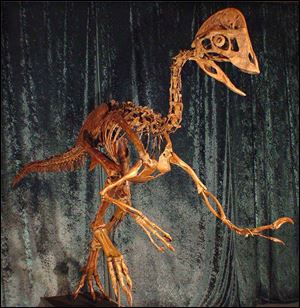
Pittsburgh history museum unveils dinosaur that’s no Chicken Little
3/23/2014
The birdlike dinosaur, Anzu wyliei, was 7 feet tall and weighed about 500 pounds when it roamed the Dakotas about 66 million years ago. Employees nicknamed the creature ‘the chicken from hell.’
PITTSBURGH — In prehistoric North Dakota, a warm, wet land roamed by turtles and crocodiles, there lived a dinosaur that experts believe looked sort of like a giant chicken.
When the bones arrived at the Carnegie Museum of Natural History a decade ago, employees looked at the 11-foot-long animal, with its beak, long neck, crested head, and slanted posture and nicknamed it the “chicken from hell.”
“He probably did look like a giant, really freaky chicken,” said Matt Lamanna, a paleontologist at the Carnegie Museum, who spent nine years studying the animal and can’t help but think of it when he eats chicken wings now.
On Wednesday, Mr. Lamanna and three other paleontologists published a paper giving the “chicken” a place in the dinosaur family tree. Now it has a more dignified name: Anzu wyliei.
Anzu, which weighed about 500 pounds, lived 66 million years ago during the Cretaceous era, shortly before dinosaurs went extinct. The species was probably an omnivore, Mr. Lamanna said, using its claws to shred leaves and its beak to eat them. It might have also dined on fruit, eggs, and tiny creatures such as lizards.
When it wasn’t eating, Anzu was probably running away from Tyrannosaurus rex through the Dakotas’ coastal floodplains.
The find sheds light on the last years of the dinosaurs, said Tyler Lyson, a paleontologist at the Smithsonian Institution and the paper’s co-author. Some scientists think that the number of dinosaur species was in decline, but adding Anzu to the list of Cretaceous species bolsters the theory that many were still around.
“The fact that we’re still finding new species in the late cretaceous indicates that dinosaur diversity was doing very well when the meteorite struck,” Mr. Lyson said.
Anzu is also important as a rare example of the oviraptorosaur genus, a cousin of the ancestors of birds. Oviraptor bones are hard to find because they were so brittle, full of tiny air ducts like the bones of birds.
The Block News Alliance consists of The Blade and the Pittsburgh Post-Gazette. Richard Webner is a reporter for the Post-Gazette.